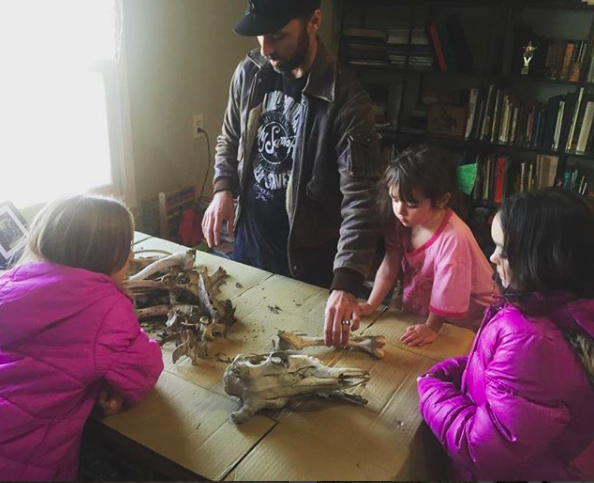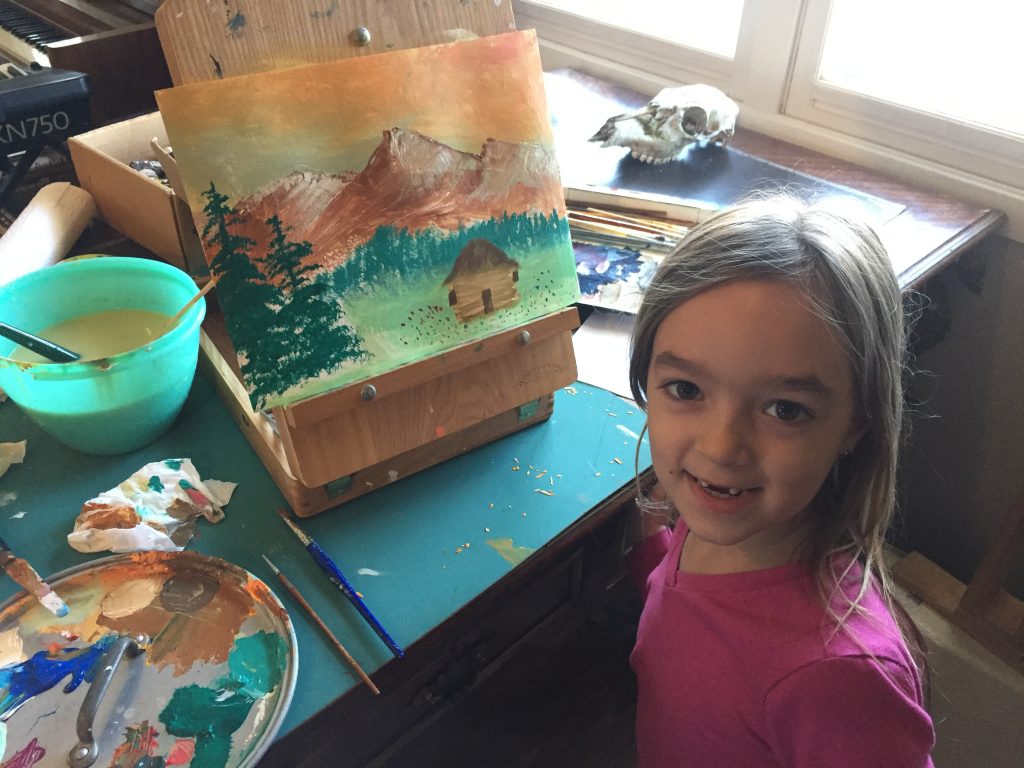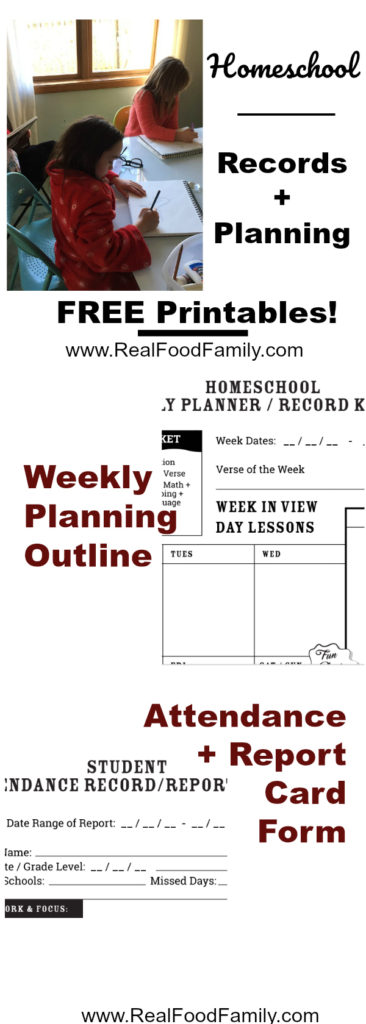When it’s time to enroll kids in school- either for the first time or for the next school year- many parents start feeling a tug on their hearts to consider homeschooling. Parents consider homeschooling for a myriad of reasons. Whatever the reasons, the whole idea comes with excitement, fear, self empowerment, self doubt, a lot of freedom and a lot of pressure.
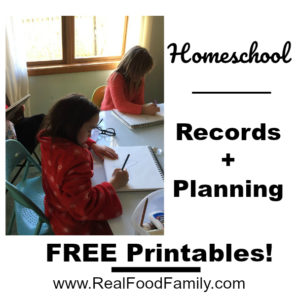
Real quick…if you want a little help organizing your homeschool life, I’ve created templates for weekly planning as well as keeping records for course work, progress, grades an attendance. Click here to download our FREE Homeschool Records + Planning Printables!
When my husband and I decided to obey “the call” to homeschool, I spent hours searching for blogs outlining exactly what homeschoolers were doing every day, hour by hour. I actually couldn’t find too many posts like this. Everyone seemed to say “there’s no right way to homeschool”, but I just wanted a checklist so I knew I wasn’t totally failing.
I put this post together to help people see how *one* homeschool family does things. Just remember, the beauty of homeschooling is creating your family’s unique form of home based education.
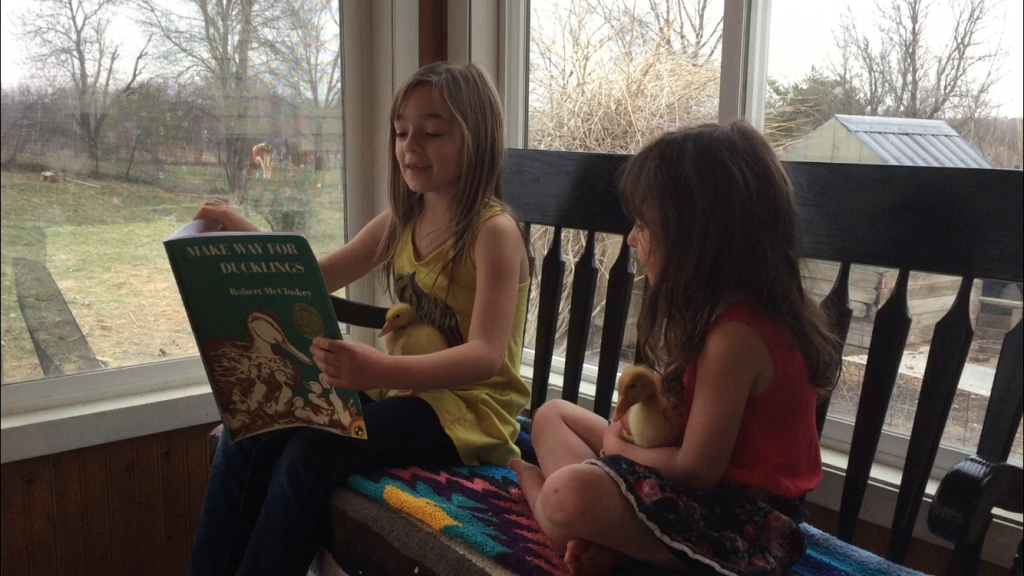
What I’ve Learned
Without turning this into a novel about what I’ve learned over my years so far of homeschooling and elaborating on every trial and error, here are some main lessons I feel the need to share:
- Don’t try to “do school” at home. School does “normal” school best- the desks, daily 7-hour schedules with one size fits all lesson plans and timed recess, classroom projects and crafts all over the walls. Don’t get me wrong, some people might enjoy crafts all over the walls of their homes. I prefer as much empty white space in my home as possible to keep my sanity. But my point is to create an incredible education experience for your family by doing what “normal” school can’t do. Take breaks, field trips, focus on one subject for a while that everyone is interested in. Sometimes encouraging quality playtime between siblings can be all you do in a day. I firmly believe these kinds of days will prove to be more valuable in the grand scheme of life than forcing academics. In our house our children are raised to be best friends no matter what. Playtime won’t last forever…the days are fleeting!
- You will constantly be judging and comparing yourself until you truly believe you have the ability to offer the best possible education for your children. It’s okay to assess what’s working and what isn’t, but you don’t need to hold yourself accountable to the mainstream school system standards, especially in the elementary years. A young person who has the ability and skills to learn, retains what they learn, and enjoys the act of learning will do much better in college and “the real world” than a student who spends K-12th grade completing checklists and memorizing meaningless facts simply for a test score and good report card.
- Don’t invest too much- financially or emotionally- in one curriculum. Most homeschooling parents have fallen in love with an all-subject curriculum only to find that it totally doesn’t work for their kids. As you will see below, I’ve settled into various curriculum choices for each subject. I go with what works, meaning both the kids and I enjoy it and it’s not a constant struggle to get the lessons done. Sometimes a program that works for us in the early elementary years does not work well past 2nd grade.
- PS- Don’t get too invested in a homeschooling philosophy. In some ways we “unschool” and in other ways we are “classical” or “traditional”. Remember that YOU get to discover, form and mold the well-rounded education experience homeschooling can offer your family.
- Spend quality time with other homeschooling parents and glean from their wisdom and experiences. Most of the programs and practices we use now were recommended from my homeschooling friends and mentors. I usually feel so fulfilled and motivated to rejuvenate my homeschooling approach after I spend quality time with my homeschooling friends. Big homeschooling conventions can be awesome, too, but sometimes you’ll fall into the trap of devoting yourself to a curriculum or philosophy that a speaker passionately promoted…so be careful.
- Ignore the ignorant critics of homeschooling but speak up when legislators challenge our constitutional right to homeschooling freedom. Plenty of people will snap snide comments delivered under the guise of “advice” or “how’s the homeschooling going” questions. Sadly this often comes from disapproving family members. Stay strong and be encouraged! Don’t engage in petty arguments. Simply walk away from close-minded confrontational people who have no actual experience in or knowledge about homeschooling. Avoid social media arguments on the subject. Save your breath for when you need to call your local and state officials to support pro-homeschooling legislation! Join the Homeschool Legal Defense Association (HSLDA) and become an active and educated proponent of this lifestyle you’ve chosen!
- As a homeschooler you must understand the laws of your state, which HSLDA can help you with. In many states you don’t have to keep any record of your child’s attendance, grades or education status. In America you don’t have to complete standardized testing or the GED to be considered a high school graduate. Colleges are not allowed to discriminate against homeschool families in this way, which the legal defense of HSLDA often helps families with. However, I personally have chosen to keep records of attendance, lesson plans, grades, some of our finished work and tests just for my own peace of mind and to keep things organized and prepared. I’m not yet sure if I’ll have my kids take standardized tests when they’re older but my goal is to keep all opportunities open for my children, whether they want to go to an Ivy League medical school or be a homemaker. I want my children to love that they were homeschooled, not resent it because they weren’t sufficiently prepared to pursue their dreams.
- When people ask what grade the kids are in, we reply with whatever grade they would be in “normal” school…but it doesn’t really mean much. I’m sure most people are not soliciting a conversation about my convictions against measuring a child’s education by their grade level when they ask what grade they’re in. The work we do and programs we use are based individual skill level. Sometimes my children are ahead of their grade level in a subject, sometimes they’re behind…or at least not learning the same things their public schooling peers are learning. Grade level standards only matter when it’s time for standardized testing, college entrance, or prerequisites for outside classes…if we so choose to do any of those things.
- Some days are going to suck. Sometimes you won’t seem to get anything accomplished for the entire day (or month). You’ll think you’re a failure. The house will be a mess and you’ll start to daydream of life where the kids are in school and you can clean the house and have a cup of coffee in total silence. In those discouraging moments I try to remember that there will be plenty of those quiet, no-kid days when the kids have left the “nest”. I’m also reminded of how impressed and inspired I am by the incredible families who have homeschooled their kids into adulthood. I know I’ve made the right choice. Even more, I know I’ve answered a specific call from God and I won’t disobey unless He leads me in another direction. For now I accept the sacrifices that come with homeschooling. I don’t always accept with grace, but homeschooling is an important learning and growing experience for me, too.
There are many more lessons I’ve learned, but those are the most important to me at this point. Now let’s get to how we do things. As I write this I’m sure I’ll keep updating as the years go by. It never stops changing, and that’s okay.
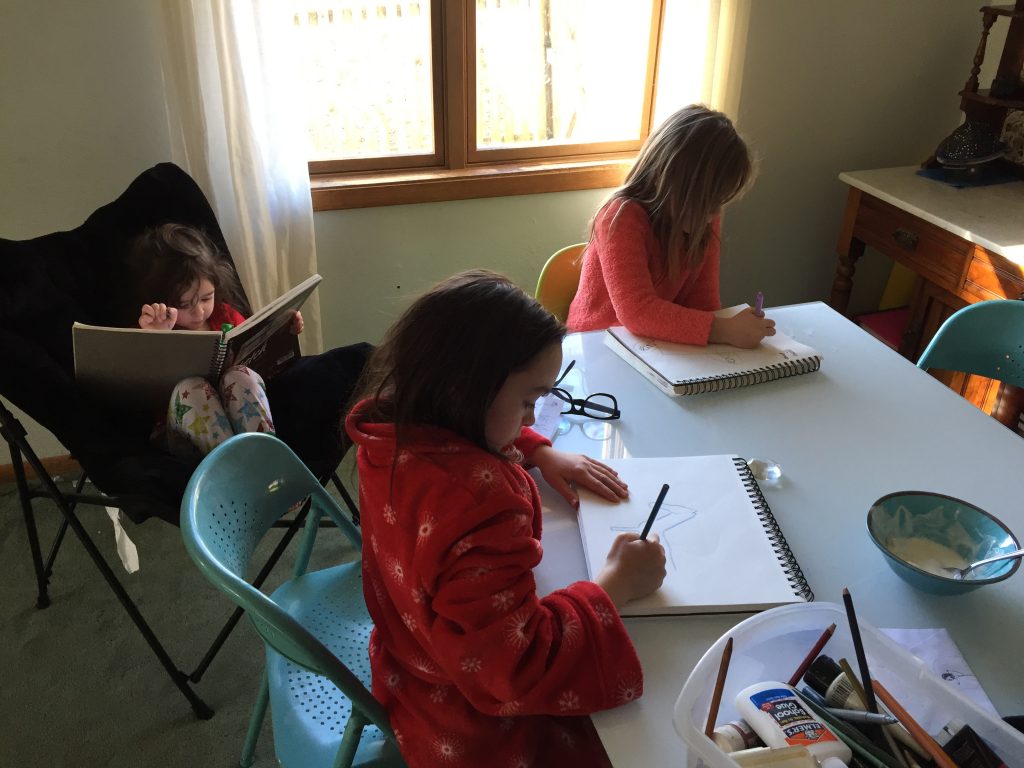
What We Do
We have three (almost four) children- currently ages 10, 7 and 3. Everything below may seem like a lot, but we usually start around 9am and are done by lunchtime. We rarely have a complete week of “normal” days. Between appointments, field trips, play dates or other random things that happen, we often skip things or do all the schooling in the afternoon instead of the morning. Sometimes work gets done in the car or at the park. That’s the flexibility of homeschooling!
How do you homeschool multiple ages? Homeschooled kids typically become very independent by third or fourth grade, or at least they are able to work on things for longer periods of time while I focus on the other kids. Having plenty of engaging activities for the little ones who aren’t actually “schooling” yet is key. I’ll give specific suggestions below.
We keep a dry-erase board on the wall listing our daily routine, including the homeschooling outline. Even though the board doesn’t change often, we all like to check in with the list to stay on track.
I also keep a pretty little “teacher journal” where I write out my notes and plans each week using my planning worksheet (available to download here). This is a way to stay organized, keep myself accountable but also keep a record of our lesson plans. I also fill out my record keeping template at the beginning of each season for my reference and accountability, as well as records I might need to provide in the future.
Finally, you might notice that I say things like “3rd or 4th” grade, not being completely grade-specific. This is because we move through schooling based on skill and appropriate learning load instead of only going by an age-based grade level.
Before We Start
I try to wake up early to stretch and have quiet time before the kids wake up, but it rarely actually happens so they get a little free time while I get going. When I’ve had enough coffee and read my morning Bible study (using this devotion book or following this women’s ministry study), I make breakfast and we sit down as a family to eat. We discuss prayer requests and pray together, then practice a weekly memory verse. We also discuss the news and watch a short “This Day In History” video from History.com.
After breakfast we all have about 30-60 minutes to:
- do the morning dishes
- feed the animals
- make beds and tidy up rooms
- brush teeth
- get dressed
My goal with morning time is to teach my children how to start the day, preparing them for an adult life of being productive in the mornings, even if they don’t have to be somewhere.
The School Day Commences
Usually at 10am we start with our “Daily Basket”, meaning the basic academic subjects we do every day. Most of these subjects include a workbook, so the kids get there “stack” of books out every day and work independently with me close by to help. When they’re done with their “Daily Basket stack”, I check their work and we will move on to the “Day Lessons” (below) together. Here’s what the “Daily Basket” looks like:
- Bible– we do one or two of the following:
- Watch “What’s In The Bible” video while coloring in the What’s in the Bible coloring book during the video or after we watch. Discuss what they are learning in the video.
- At 4th-5th grade we introduce a study book like this one that is usually read while the younger kids do What’s in the Bible.
- Write out the weekly Bible verse in our Bible Verse Journals. Practice memorizing weekly verse.
- Special project based on the video lesson or another “life-inspired” topic
- Mission focus- watch video or learn about missionary work or lifestyle of other cultures or people in need around the world
- Always Be Ready and Answers in Genesis are fantastic apologetics resources to teach a defendable biblical worldview. We might refer to these websites to discuss tough questions or topics.
- The preschooler enjoys watching the videos and scribbling on a coloring page. Preschoolers memorize Scripture, too!
- Math
- We currently use the MathUSee curriculum for everyone and LOVE it! Finding a math program that we really enjoyed was extremely difficult and took a couple years. We all truly enjoy MathUSee- both the math whiz kid and the one that hates math. I highly recommend it.
- The preschooler loves playing with unit cubes, geometric blocks, and counting cards while we do math. She also uses the smartphone app “letter school” to learn how to write numbers. We’ve started the “Primer” book of MathUSee with our just-turned-4 year old and she’s absolutely ready for it. Some kids wouldn’t be ready this young, and I definitely wouldn’t force it.
- English
- For Kindergarten through 1st or 2nd grade we love the Logic of English Foundations curriculum. My second child taught herself to read using the Logic of English phonograms smartphone app! We’ve chosen to teach cursive right from the beginning (kindergarten) which you have the choice to do with Logic of English. By the end of the foundations books they can write full sentences in cursive and know most of the phonograms in the English language, including ALL the sounds the phonograms make. For instance, most of us learned that the letter “a” has a long and short sound. What about the third sound as in the word “wash”? In kindergarten they will learn all six sounds of the phonogram “ough”. In Logic of English you learn the rules for the entire language instead of falsely being taught (as I was growing up) that half of the English language is “exceptions” to the rules that you have to cross your fingers and hope you remember. The Foundations curriculum has four parts (A, B, C, D) that usually take two years to complete.
- We introduced the SpellingYouSee and I’m enjoying this as the main choice for 2nd or 3rd grade and above. I find the program to me more conceptual and engaging, which was lacking in the upper level of Logic of English (sorry!). In this curriculum there are historical readings and dictation that they learn from so it isn’t so “academic”. This was especially needed for our oldest child’s English lessons because I was losing her interest and getting frustrated. I anticipate this will be the case for all my other kids.
- We complete a Scholastic Reading comprehension worksheet and Scholastic Vocabulary worksheet daily. I buy these based on skill/grade level and complete the full book before moving on to the next. If you keep up with these daily you will move through the “grade levels” quickly.
- Starting in 3rd or 4th grade we complete a “Daily Gram” grammar worksheet daily. These workbooks are very vague so usually a parent is needed to offer more instruction than what is given, but it does the job for quick grammar practice. There are good smartphone apps for grammar practice as well, which I like to use.
- With the preschooler we read the Logic of English Doodling Dragons books and let her play the “letter school” app, the Logic of English app and other educational reading apps.
- Reading & Summary Writing/Book Reports
- After lunchtime we we like to spend time cleaning up the house then playing. After this we come in for a good hour of “reading time”.
- We have reading time together then independent reading time where they read something they enjoy. If they aren’t enjoying a book after a couple days I won’t force them to keep reading. We’ll find something else they like. (I’ve listed my kids’ favorite reading books in the resources list below.) Usually I ask for 20-30 minutes of quiet independent reading time, sometimes more or less. The younger ones can go play quietly in their room or outside if they’ve read enough and can’t focus anymore.
- Once the kids can read and write independently we add summary writing and book reports to “reading time”. It’s important to teach the kids how to write notes or keep a summary journal as they work through a book. This practice should start very simply. The younger kids use a “draw and write” journal to practice reporting what they’ve read about. As the kids get older we start practicing note taking and forming reports and essays. I’ve found basic worksheets for report outlines online. Correcting their summary and report writing is how we work on spelling and grammar as well as enhancing writing skills.
- We still read aloud through chapter books with the kids, usually at bedtime. During the daily reading time I’ll read a book aloud to my preschooler. Sometimes we will use reading time to read a book aloud together, especially on Tuesdays, which is my day for focus on literature and poetry (see “After the Basics” below). Most of our reading aloud books are from the “Favorite Books” list below.
- While we don’t yet incorporate it into our homeschooling, the Institute for Excellence in Writing is something I plan to incorporate in the future. The program starts at third grade but I think I might start it in middle school or when my kids have more interest in writing. We are still developing that skill and I want writing to be something of interest and passion, not forced.
- Typing
- We use an online program called Typing Instructor. There are lessons and games. It’s a relatively primitive program but it gets the job done. I’m still trying to find the super awesome typing games I grew up with!
- Foreign Language
- We have dreams of being a multi-lingual family, but this subject often takes a back seat, to be honest. I guess I’m relying on extended yearly trips to Europe to cover this subject. (That only a sort-of joke.) I haven’t brought myself to purchase an expensive foreign language program yet, but it’s on my wish list. For now we use smartphone app games and I found this fun little DVD for the kids that has basic lessons in 6 different languages.
After the Basics
I’ve designed our homeschooling outline to get the basic academic subjects done first, then each day has a special focus on a particular extra subject.
Monday- Art
For art lessons we either draw in our nature journals (a mixture of science and art), follow an art lesson on YouTube, or learn about a famous artists and do artwork inspired by the artist. We will bring out the nature journals on Science day, too (Friday), to add notes or finish our work. Everyone in the family usually participates in the art projects and lessons. My husband is a very talented professional artist. I, on the other hand, tend to draw the same way I did in third grade. So this is a fun learning time for everyone.
Tuesday- Literature and Poetry
In addition to our normal reading time, on Tuesdays we focus extra time on literature and poetry. Usually I am reading aloud to the kids with a book from Five In A Row*, or a chapter book that we are reading through together. Sometimes we read, write and memorize poetry. We might also focus on an author, writing style, vocabulary, or art style in a book.
*Five in a Row is a wonderful homeschool curriculum that we have used fully in the past but now we use more of as a supplement. The Five in a Row curriculum is about reading a book five days in a row and deriving lessons for all subjects based on the subject(s) in the book. When kids get older they read chapter books and lessons are derived from the chapters. I absolutely love the concept of Five in a Row, but as I mentioned in my “lessons learned” above, it didn’t work as our full time curriculum. I’m not sorry that I’ve invested in the teacher guides and reading books- they are fantastic books and inspiring suggestions for the teacher. I started with Five in a Row by going to the library for the books every week, but then decided to purchase all the reading books, which I have linked to in our “Favorite Books” list below. They are a wonderfully diverse collection of the best children’s books that we will continue to read year after year. Quite often we still derive our other “after the basics” subject lessons for the week from the book we read on Tuesday. I will leave the weekly book out in the living room and quite often the kids pick it up on their own to read it again. Needless to say I still feel very blessed by the Five in a Row reading books!
Wednesday- Music and Performing Arts
We are a music and performing arts family, so I will always value and prioritize this area of education even if the mainstream school systems are removing them. I can teach basic piano, singing and dance myself, but I encourage everyone to find local and online resources for lessons for your kids. There are many community, church and online options that are free. My dad, Gene Roberson, is helping us develop music lessons that we can share for other families to do together.
One of our favorite activities is listening to a classical symphony and coming up with a story as it plays that we either act out or narrate with improvisation. Usually different instruments will clearly represent certain animals or characters that return to the story whenever the instrument is played. If you like this idea, I suggest you start with the Peter and the Wolf suite by Sergei Prokofiev. After that, save your local classical radio station in your car and play this “game” on car rides.
Don’t forget the value of creative music and performing arts time! Let your kids make up songs, dances, plays and movies! Kids learn SO much by doing this at home with siblings and friends. Kids will expose the strengths and weaknesses of their temperaments as they figure out who the director, choreographer, star and supporting performers will be. PLEASE encourage their show time, too. Kids need to feel that their creative efforts are applauded. Help them create flyers for neighbors, a stage, costumes and a set. My poor neighborhood had to deal with my constant productions I directed with the neighbor kids when I was growing up. But I ended up performing on Broadway (with a nice income) so don’t underestimate the importance of performing arts in a child’s education!!!
PS: We have music playing all day in the house. I find that music significantly improves the atmosphere of the home. I tend to get angry and stressed out easily and my (all girls) children like to bicker a lot. Music does wonders to change everything! I find that since we added constant music to the background of the home, we all stay calm, focused and inspired. We like soft classical music, instrumental worship music, and acoustic guitar or piano music. I’ve heard that Mozart music uniquely activates both sides of the brain. Typically Mozart isn’t great background music, but maybe so if it’s quietly played. Music with lyrics are too distracting during educational and reading time. We have a premium Spotify membership that more than pays for itself since it will play a selected style of music endlessly for you with no commercials or interruptions.
PPS: Keeping a diffuser of essential oils going all day alongside the music is even more effective, and pretty much magical. Thank you, Jesus, for music and essential oils! And lattes!
Thursday- History & Social Studies
We typically do interest-led history lessons. We like to check in on the History Channel’s daily “This Day In History” video on their website. Perhaps there’s a holiday or special event in the news that sparks a particular interest. We’ve listened to “Adventures in Odyssey” episodes that introduce a historical topic which leads to many days or weeks of exploration of the topic. Whatever the inspiration is, we try to dive into a historical event or topic as long as needed. Geography, critical thinking and social studies are always covered in our exploration and discussion of history.
Videos are a very effective way of teaching history. Our favorite videos and shows are “Learn Our History”, Liberty’s Kids, What’s in the Bible (also our Bible lessons), and a series from the History Channel called “American Genius”, but only for kids 8 years old and older, I think.
We keep a “History Timeline Notebook” to keep track of our history explorations and projects. This is a large empty scrapbook from the art store. We add scrapbook-sized pages filled with information and pictures as we learn about historical events. We add the finished pages to the notebook in historical order, placing the page where it should go within the other pages. Adding pages to the notebook always inspires a review of the pages we’ve already added. I came up with this idea of a long-term history lesson collection to help keep a more cohesive understanding of history through our years of learning, and beyond. I grew up learning history so randomly that I never really grasped when events occurred in relation to each other or in the grand scheme of time. I’m enjoying creating this history notebook for myself as my own hobby.
One day when I had a lot of time to spare, I drew a couple timelines of human history based on different eras and major events. When we study a historical subject I’ll often have everyone take a look at my timelines so we can get a full perspective on when it happened.
Friday- Science
Science in the elementary years is generally random and experimental. Most schools aren’t teaching a semester of chemistry or biology until junior high school. Regardless of what the “normal” schools do, we explore science with a very organic approach…pun intended. Our science lessons are influenced by interest: the weather, an animal we saw, a deer carcass we discovered, something unusual that happened in our backyard or in the news, a scientific topic book we read or historical figure we learned about, a funny thing we saw on America’s Funniest Videos.
There’s a lot of science to be learned as a homesteading and homeschooling family. We have plenty of hands-on death, life and outdoor exploration opportunities. We have the time to dive into cutting edge technology and engineering. It’s easy to cover science since we have the liberty to just get outside, go to a museum or zoo whenever we want to!
One thing we’ve invested in for science is monthly Kiwi Crates! These are $20 monthly boxes with a super fun science experiment or engineering creation. My kids absolutely love these subscription boxes! I was on the fence about spending $20 per month on the one-day craft, however that money is totally justified by the fact that I would spend way more than that buying the supplies every month from the crafts store AND there is a magazine full of extra activities and experiments based on the subject of the monthly activity and subjects learned. I think it’s well worth the money and keeps us active with cutting edge science lessons for kids.
We have invested in a couple textbooks and workbooks for science from the Apologia program. We don’t use these books consistently, but they are a fantastic resource to open when we want to study a certain subject like animals or human anatomy. The Apologia program is another wonderful all-subject curriculum available if you’re interested in more from them.
If you’re interested in Creation science, we suggest checking out the Answers in Genesis ministry!
Finally for science, we love the OLD Magic School Bus episodes which are on Netflix, or available for purchase here.
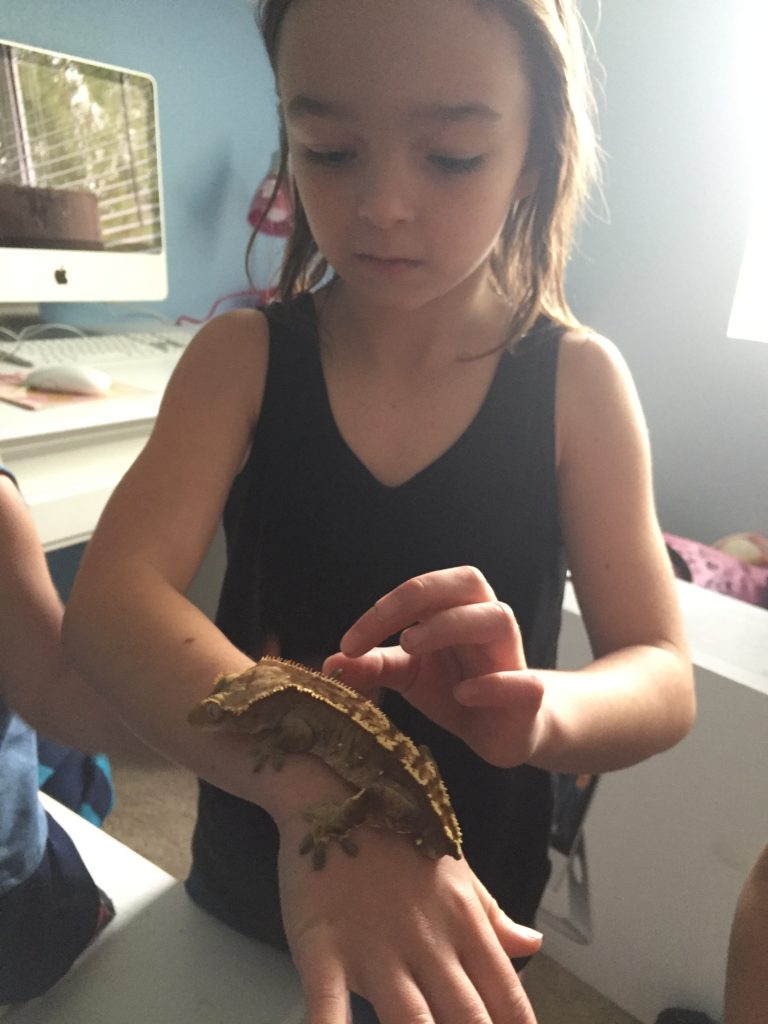
Afternoons
We are very active in gymnastics and dance, as well as our homestead and hobbies. We also value free play and sibling time together. Of course we do allow some Netflix time. Most afternoons are spent doing these activities or finishing up homeschooling projects. Errands, chores and house projects often take up the afternoon hours, too.
Not-Normal Days, Months or Seasons
Most people know the scripture from Ecclesiastes about “a time for every purpose under heaven”. Sometimes there’s a new baby, or an illness, or a tragedy, or an “all hands on deck” farm need, a major life change, a vacation, or simply a season that requires a break from our normal daily homeschooling routine.
There’s a billboard in my town that claims something like, “2 absences per month = higher chance of failing high school”. This may apply to the “checklist and report cards” style of schooling, but not necessarily homeschooling. Of course I believe in the importance of teaching children responsibility, commitment and consistency. One day they’ll likely have a job- including motherhood- that requires them to show up no matter what the life situation is. They can’t just take hours or days off whenever they feel like it or they’ll get fired, or the baby won’t be too happy.
However, our approach to education is a holistic one. This means it’s a 24/7, always-part-of-life experience. We believe there is education in all areas of life, including difficult or unusual seasons. “School” for us doesn’t have an on-and-off switch. It’s always on. We might pick up routine and a heavier academic load at times, but sometimes the events of life become more important and we step back from the normal routine.
As a homeschooling family, you must give yourself grace. Stop comparing yourself to other families or the public school system timeline and checklist. Remember, if you’re always comparing you will always see your “failures” instead of trusting God’s call on you to educate your children from home. God has given your family a uniqueness that should be reflected in your approach to homeschool.
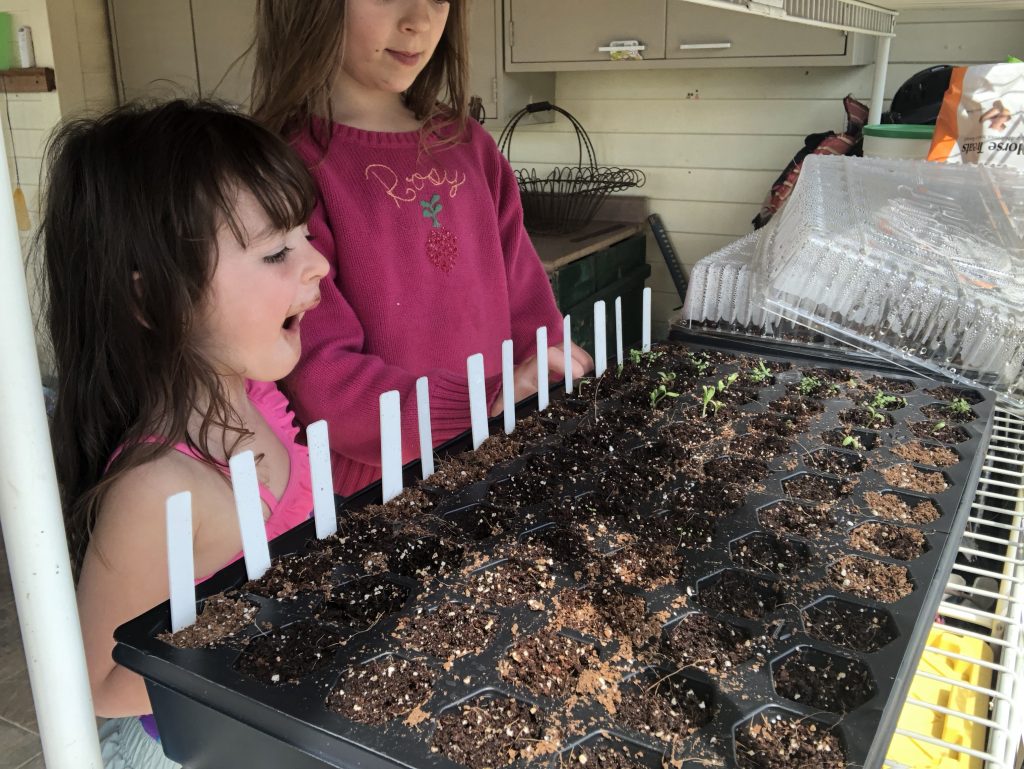
Favorite Reading Books and Resources
Favorite Reading Books for the Kids (For them to read or for family read aloud)
- Imagination Station series (My oldest daughter read these furiously- like one book every day or two. We have a very difficult time finding books she is interested in so we were thrilled with this series!)
- The Little House book series
- I Can Read Readers
- Rush Revere Books
- Five in a Row Reading Books- preschool book set, volume 1 set, volume 2 set, volume 3 set, volume 4 set
Educational Links and Resources
- My “School at Home” Pinterest board with my favorite homeschooling links
- What’s in the Bible
- Logic of English
- Math U See
- Spelling U See
- Five in a Row
- Institute for Excellence in Writing
- My favorite art lessons YouTube channel
- Kiwi Crates
- Learn Our History
- Liberty’s Kids Series
- Gene Roberson’s music website– follow him for when new kid lessons become available!
- Apologia curriculum
- Magic School Bus- the ORIGINAL series, not the new ones!
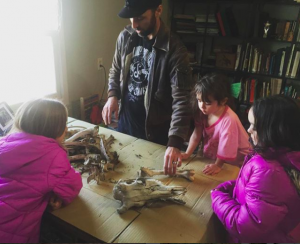
I love to share our homeschooling and family adventures on social media, so be sure to follow Real Food Family on Facebook and Instagram. Homeschooling posts get the hashtag #realfoodfamilyhomeschool.


